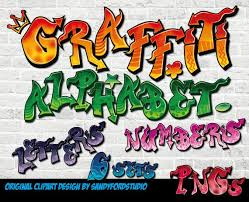- The word graffiti was first used by archaeologists around the year 1850 to describe scratched inscriptions found at ancient archaeological sites. Graffiti comes from the Italian word graffito, which translates to something scratched.
- Modern graffiti appeared in Philadelphia in the early 1960s, and by the late sixties it had reached New York. Young people used spray paint to create images on buildings and on the sides of subway trains. They soon realized that the subway system was a moving canvas for their art.
- If the artist has permission to do graffiti, it is art. If a person does it without permission to someone else's property, it is vandalism. Some graffiti artists are hired and paid to create community murals in public spaces or on buildings, and this is viewed as art and not as vandalism.
- Tagging refers explicitly to writing the artist's name, alias, or logo on a public surface.
- The common perception is that the symbols and phrases spray-painted on walls and train cars are visual communications between street gangs, but some graffiti is not gang-related.
- Gang graffiti is used by gangs to mark their turf or convey threats of violence.
- Graffiti can be viewed as antisocial in an effort to gain attention, but it can be understood as an expressive art form.
- While the art form is known as graffiti, these spray paint artists call themselves writers. This originated with the Greek term graphein, or to write.
- Toy is used as an adjective to describe poor work, or as a noun meaning an inexperienced or unskilled writer.
- Cannon(s) is the slang term for spray paint cans.
- Bomber is a type of graffiti writer who specializes in writing their name in as many places as possible. The aim is to gain as much notoriety as possible for one's moniker or tag. In the early 1970s, The New York Times wrote about a bomber named TAKI 183 who tagged the city's subways. (more on TAKI 183 to come)
- Graffiti on trains has a long history in the U.S. The first appearing in 1827 on the Baltimore & Ohio Railroad, the oldest railroad in the U.S.
- The first markings were coded messages written in chalk and pencil by railroad workers to communicate with colleagues in other cities.
- During the 1930s, hobos and railroad workers left markings on freight cars. As rail travel became a popular way to travel cheaply, hobos began leaving hidden markings on boxcars.
- Graffiti continues to be a part of the railroad culture. The practice of watching for graffiti on trains is called benching. The practice originated in New York, where graffiti writers and non-graffiti writers would sit on benches at train stations to take pictures and admire the graffiti.
- Being well-respected is a goal for a graffiti writer. Painting trains is the best way to achieve this status. Graffiti writers who paint trains with an outstanding style in a high-risk environment, such as a train yard, achieve a large amount of respect from other writers. It shows their willingness to risk everything for graffiti. They become inspirations for other writers. Graffiti on trains achieves more recognition than writing on walls.
- The level of exposure makes trains the perfect canvas for graffiti writers, to be noticed by as many people as possible.
- Train systems across the globe have increased and improved security of their train yards since the 1990s. Graffiti artists must plan and find cunning ways to get into train yards. Graffiti artists who paint trains run the risk of violating trespassing laws.
I'm hoping my followers will have fun along with me on this zany adventure. Already I'm feeling the urge to go benching!

